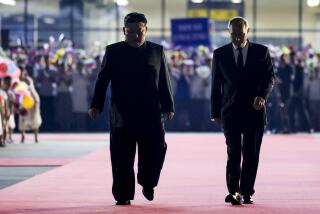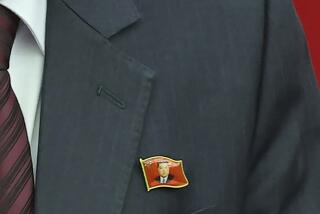Out With Old, In With New for Kim Jong Il
TOKYO — One by one, the old-timers still clinging to power around North Korea’s mysterious leader, Kim Jong Il, are dropping away. In the past month, the Communist regime’s chief ideologue, its prime minister, two top military leaders, its vice minister of foreign affairs and an economic official all have defected, been deposed or died of “incurable” diseases.
Is it mere coincidence or a chilling conspiracy?
The isolated regime defies attempts at authoritative analysis, but North Korean watchers generally seem to agree on three things: As he prepares to assume formal leadership roles this year, Kim is reshuffling his team faster than expected in favor of younger leaders.
The “first-generation revolutionaries”--men, mostly in their 70s, who fought against the Japanese in Manchuria under Kim’s revered father, the late Kim Il Sung--are being squeezed out.
The dramatic defection last month by Hwang Jang Yop, a chief architect of North Korea’s nationalist juche philosophy of self-reliance, is said to have accelerated the reshuffling.
Questions persist as to whether the deposed or deceased officials were forcibly removed, especially given a South Korean news report that four other senior officials had planned to defect with Hwang but were discovered.
Second, analysts agree that Kim has vastly strengthened the military--evident from his selection of officers to fill 61 of 85 spots on the funeral committee for Choe Kwang, the late defense minister, who reportedly died of a heart attack Feb. 21 at 78. In a congratulatory birthday message to the North Korean leader in February, officials declared the military “the core of the revolution group,” fueling speculation that the armed forces had usurped the party in importance.
And third, while some analysts argue that Hwang’s defection signaled the flight of reform-minded intellectuals in the face of an increasingly powerful military clique, most agree that Pyongyang has refrained from the belligerent acts one might expect from hard-liners.
North Korean officials attended a briefing this week on proposed peace talks among the United States, China and the two Koreas, pledging to listen to “whatever proposals . . . promote peace and security on the Korean peninsula.”
The regime has indicated a willingness to allow Hwang--who remains holed up in the South Korean Embassy in Beijing--to settle in a third country. And it offered an unprecedented expression of “regret” for sending a spy submarine into southern waters last year.
Still, some analysts worry that the apparent flexibility shown by North Korea’s leaders is merely a tactical ploy to coax international food aid for their starving populace of 23 million.
The nation faces a full-blown famine that experts say could approach the scale of past disasters in Ethiopia and Somalia and lead to widespread death, social chaos and a mass exodus of refugees to neighboring countries.
InterAction, a U.S. council of humanitarian groups, said severe floods in the past few years have deepened a food shortage that now threatens to reach 2.5 million tons this year--enough to feed 12 million people in 1997. People are systematically foraging for roots and at times receive less than half a bowl of rice a day; the old are sacrificing their portions to feed the young. Without relief, severe malnutrition is expected to set in by May, the group said in a January statement.
But Pyon Jin Il, editor of the Korea Report in Tokyo, said Kim’s personnel changes have put into place younger military leaders who do not know the horror of war and might be more inclined toward aggression once they get the food aid in hand.
“North Korea’s strategic target has not changed yet: unification [of the Korean peninsula] under the socialist system,” Pyon said. “The developments are getting a bit dangerous.”
(BEGIN TEXT OF INFOBOX / INFOGRAPHIC)
Who’s Who in Kim Jong Il Regime
As he prepares to assume formal leadership roles, North Korean leader Kim Jong Il is reshuffling his team of advisors faster than expected in favor of younger leaders. Among the changes:
Who’s Out
* Hwang Jang Yop--Korean Workers’ Party secretary for foreign affairs. Requested asylum through South Korean Embassy in Beijing on Feb. 12.
* Choe Kwang--Minister of the People’s Armed Forces. Died Feb. 21, reportedly of a heart attack.
* Kim Kwang Jin--First vice minister of the People’s Armed Forces. Died Feb. 27, reportedly after a “lengthy illness.”
* So Kwan Hui--Secretary of agricultural affairs. Has not been involved in any formal functions for nine months.
* Kim Won Chon--Member of the Cabinet’s agricultural committee. Has not been noted in public since he attended rally Nov. 14.
* Kim Chang Chu--Deputy prime minister for agriculture. Has not appeared at any public function since Oct. 10, 1995.
****
Who’s In
* Chang Song Taek--Most powerful younger-generation leader. In charge of party personnel promotions and assignment; married to Kim Jong Il’s sister.
* Yi Yong Chol--Monitors the generals.
* Hyon Chol Hae--Deputy director in charge of organization of the People’s Armed Forces’ General Political Bureau, which administers military promotions and reassignments.
* Kim Kyong Hui--Director of the Economic Policy Audit Department of the Korean Workers’ Party. Kim Jong Il’s sister.
* Chang Song U--Commander, People’s Security Force. Brother of Chang Song Taek.
* Yi Myong Che--Secretary to Kim Jong Il. Runs his household and makes policy recommendations.
Source: Weekly Chosun, Naewoe Press
More to Read
Sign up for Essential California
The most important California stories and recommendations in your inbox every morning.
You may occasionally receive promotional content from the Los Angeles Times.











